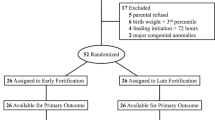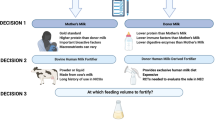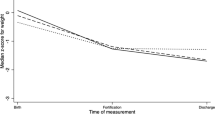Abstract
Background
Human milk-based fortifiers (HMBF) are more costly than bovine milk-based fortifiers (BMBF); but, the efficacy of human or bovine fortification for infants born <1250 g has yet to be fully elucidated. Our objective was to determine the effect of fortifier source on tertiary neonatal costs.
Methods
Costs associated with tertiary neonatal care, including direct and indirect hospital expenditures, feed-related costs and physician billing were analysed retrospectively for participants of OptiMoM (NCT02137473), a blinded RCT comparing fortifier type for babies born <1250 g. A generalized linear model of cost according to fortifier type was created.
Results
Mean [95% confidence interval] daily costs per patient, adjusted for birth gestation and weight, was significantly greater in the human than the BMBF group ($3,452 [$3,186 – $3,740] Canadian dollars (CAD) versus $2,451 [$2,257 – $2,662] CAD) respectively, p < 0.0001).
Conclusion
HMBF usage entails additional costs on NICU stay that should be considered with implementation.
This is a preview of subscription content, access via your institution
Access options
Subscribe to this journal
Receive 12 print issues and online access
$259.00 per year
only $21.58 per issue
Buy this article
- Purchase on SpringerLink
- Instant access to full article PDF
Prices may be subject to local taxes which are calculated during checkout
Similar content being viewed by others
Data availability
The datasets generated during and/or analysed during the current study are not publically available due to a risk for breeching patient confidentiality but may be available from the corresponding author on reasonable request.
References
Parker MG, Stellwagen LM, Noble L, Kim JH, Poindexter BB, Puopolo KM. Section on Breastfeeding, Committee on Nutrition, Committee on Fetus and Newborn. Promoting human milk and breastfeeding for the very low birth weight infant. Pediatrics 2021;148:e2021054272.
Brown JVE, Embleton ND, Harding JE, McGuire W. Multi-nutrient fortification of human milk for preterm infants. Cochrane Database Syst Rev. 2016;5:CD000343.
Sandhu A, Fast S, Bonnar K, Baier FJ, Narvey M. Human based Human milk fortifier as Rescue Therapy in Very Low Birth Weight Infants Demonstrating Intolerance to Bovine-Based Human Milk Fortifier. Breastfeed Med. 2017;12:570–3.
Quigley M, Embleton N, McGuire W. Formula versus donor breast milk for feeding preterm or low birth weight infants. Cochrane Database Syst Rev. 2019;7:CD002971.
Premkumar MH, Pammi M, Suresh G. Human Milk Derived Fortifier versus Bovine Milk Derived Fortifier for Prevention of Morbidity and Mortality in Preterm Neonates. Cochrane Database Syst Rev. 2019;11:CD013145.
Sullivan S, Schanler RJ, Kim JH, Patel AL, Trawöger R, Kiechl-Kohlendorfer U, et al. An Exclusively Human Milk-Based Diet is Associated with a Lower Rate of Necrotizing Enterocolitis Than a Diet of Human Milk and Bovine-milk Based Products. J Pediatr. 2010;156:562–7.
Hair AB, Peluso AM, Hawthorne KM, Perez J, Smith DP, Khan JY, et al. Beyond Necrotizing Enterocolitis Prevention: Improving Outcomes with an Exclusive Human Milk-Based Diet. Breastfeed Med. 2016;11:70–5.
Herrmann K, Carroll K. An Exclusive Human Milk Diet Reduces Necrotizing Enterocolitis. Breastfeed Med. 2014;9:184–90.
Assad M, Elliot MJ, Abraham JH. Decreased cost and improved feeding tolerance in VLBW infants fed an exclusive human milk diet. J Perinatol. 2016;36:216–20.
O’Connor DL, Kiss A, Tomlinson C, Bando N, Bayliss A, Campbell DM, et al. Nutrient enrichment of human milk with human and bovine milk-based fortifiers for infants born weighing <1250 g: a randomized clinical trial. Am J Clin Nutr. 2018;108:108–16.
Ganapathy V, Hay JW, Kim JH. Costs of Necrotizing Enterocolitis and Cost-Effectiveness of Exclusively Human Milk-Based Products in Feeding Extremely Premature Infants. Breastfeed Med. 2011;6:1–9.
Zupancic JAF, Richardson DK, O’Brien BJ, Schmidt B, Weinstein MC. Daily Cost Prediction Model in Neonatal Intensive Care. Int J Technol Assess Health Care. 2003;19:330–8.
Petrou S, Davidson LL. Economic issues in the follow-up of neonates. Semin Neonatol. 2000;5:159–69.
Ontario Ministry of Health and Long Term Care. Schedule of Benefits Physician Services under the Health Insurance Act, 2015. Available at: www.health.gov.on.ca/en/pro/programs/ohip/sob.
Trang S, Zupancic JA, Unger S, Kiss A, Bando N, Wong S, et al. Cost-effectiveness of Supplemental Donor Milk Versus Formula for Very Low Birth Weight Infants. Pediatrics. 2018;141:1–10.
CANSIM table 18-10-0005-01: Consumer price index, annual average, not seasonally adjusted. 2019. Statistics Canada. Available at: https://www150.statcan.gc.ca/t1/tbl1/en/tv.action?pid=1810000501.
de Souza RJ, Eisen RB, Perera S, Bantoto B, Bawor M, Dennis BB, et al. Best (but oft-forgetten) practices: sensitivity analysis in randomized controlled trials. Am J Clin Nutr. 2016;103:5–17.
SAS statistics for Windows [software], Version 9.4. Cary, NC. SAS Institute; Released 2013. https://documentation.sas.com/doc/en/pgmsascdc/9.4_3.5/whatsnew/titlepage.htm.
R Core Team (2020). R: A language and environment for statistical computing. R Foundation for statistical computing, Vienna, Austria. URL https://www.R-project.org/.
Johnson TJ, Berenz A, Wicks J. The Economic Impact of Donor Milk in the Neonatal Intensive Care Unit. J Pediatr. 2020;224:57–65.
Richardson DK, Zupancic JAF, Escobar GJ, Ogino M, Pursley DM, Mugford M. A Critical Review of Cost Reduction in Neonatal Intensive Care I. The Structure of Costs. J Perinatol. 2001;21:107–15.
Acknowledgements
Fees incurred for analysis of costs were kindly waived by the finance departments of Sinai Health and The Hospital for Sick Children.
Funding
This work was funded by the Canadian Institutes of Health Research by a grant to SU, DO and AK (CIHR FDN 143233). CIHR had no role in the design and conduct of the study.
Author information
Authors and Affiliations
Contributions
The study design was conducted by TY, AR, NB, ST, DOC and SU. Data analysis was performed by TY, AR, AG, and AK. The manuscript was prepared by TY and critically edited by AR, NB, ST, AK, DOC, and SU.
Corresponding author
Ethics declarations
Competing interests
The authors declare no competing interests.
Ethics approval
This study was performed in accordance with the Declaration of Helsinki. Research ethics approval was obtained from Mount Sinai Hospital (REB number 14-0044-A) and The Hospital for Sick Children (REB number 1000063564).
Additional information
Publisher’s note Springer Nature remains neutral with regard to jurisdictional claims in published maps and institutional affiliations.
Supplementary information
Rights and permissions
Springer Nature or its licensor (e.g. a society or other partner) holds exclusive rights to this article under a publishing agreement with the author(s) or other rightsholder(s); author self-archiving of the accepted manuscript version of this article is solely governed by the terms of such publishing agreement and applicable law.
About this article
Cite this article
Yeung, T., Rolnitsky, A., Bando, N. et al. A comparison of tertiary level NICU costs for infants born <1250 g supplemented with human versus bovine milk-based fortifiers. J Perinatol 43, 1113–1118 (2023). https://doi.org/10.1038/s41372-023-01677-6
Received:
Revised:
Accepted:
Published:
Issue date:
DOI: https://doi.org/10.1038/s41372-023-01677-6



